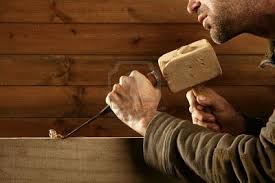Removing Heavy Surface Debris
Sometimes the piece of found wood has a very heavy amount of really punky surface. We will have to get down to the fine, hard finished surface to create our art. This is why I suggest you always have some type of probe that will penetrate the surface of a chosen pIece to see how far down we have to go to get to the good wood. Then if the wood is thick enough to allow us to remove that spalted punk surface we should consider the options we can use to quickly work it down.
Some people are just resigned to scraping that debris off. This can be a tedious job, so let’s explore some other methods. Several of us have tried sandblasting but this often goes too far and could leave some debris embedded in the wood. This could ruin our tools as we work. There is a method called soda blasting which is much less invasive but could be not only costly, but then replaces our accomplishments with the mechanical solution. Grinding and power flap wheels are also effective, but could destroy those fine points and edges that would make a sculpture unique.
There is a method called soda blasting which is much less invasive but could be not only costly, but then replaces our accomplishments with the mechanical solution. Grinding and power flap wheels are also effective, but could destroy those fine points and edges that would make a sculpture unique.
The most effective and least invasive solution is to use a mallet and a chisel to do the work. Then we have total control over how deep you wish to go and how much care you wish to give this process. Some of those bigger pieces could be approached with a regular chisel and mail it. I preferred to use a flat edge screwdriver and a small rubber or plastic smell it and remove a small amount at a time. Make sure your sculpture piece is firmly wedged or held by a vice (be sure to put foam around your piece so that device will not mar it.) Then tap the tool you are using gently to see how easy or hard it must be driven to remove just the punk area. This technique will be a wonderful help to you after you master this method. Grizzly, and I am sure other tool suppliers, will have places to order the many chisels if you should want them.
While learning the art of chiseling, practice on something other than the prize sculpture piece you are working. You should minister this technique easily and quickly.
Arline De Palma
